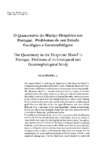Mostrar o rexistro simple do ítem
O Cuaternario do Maciço Hespérico em Portugal. Problemas do seu Estudo Geológico e Geomorfológico
| dc.contributor.author | Ferreira, A. Brum | |
| dc.date.accessioned | 2010-01-22T13:23:09Z | |
| dc.date.available | 2010-01-22T13:23:09Z | |
| dc.date.issued | 1995 | |
| dc.identifier.citation | Cadernos do Laboratorio Xeolóxico de Laxe, 1995, 20: 37-55 ISSN: 0213-4497 | es_ES |
| dc.identifier.issn | 0213-4497 | |
| dc.identifier.uri | http://hdl.handle.net/2183/6187 | |
| dc.description.abstract | The major problem in studying the Quaternary in the Hesperian Massif in Portugal is unquestionably posed by the scarcity ofdeposits, faunas and floras, which makes it difficult to establish a more or less accurate chrono-stratigraphy. The Hesperian Massif is a morpho-structural unit in a regime of tectonic uplifting and for that reason erosion in it clearly prevails over sedimentation. Accordingly, studies ofthe Quaternary in Portugal inevitably tend to concentrate on the coastal regions and on the vestibular sectors of valleys, where existing beaches, terraces and caves display a sizeable palaeontological and archaeological spoil. Also inevitably have of late the upper Pleistocene and above all the Holocene been at the heart of the most remarkable advance in knowledge, because not only of more abundant vestiges but also of the easier achievement of an absolute chronology based on radiocarbon. One problem which immediately arises is the very question ofthe dividing line between the Tertiary and the Quaternary. Traditionally, and in the absence of more reliable indicators, that dividing line has been defined inland through the raña deposits, and on the littoral 00 the basis of forms and deposits to which a Calabrian age has been normally ascribed. Rañas are, however, rigorously azoic deposits; ofthem it is known only that they constitute the more recent deposits of large planation surfaces in the Hesperian Massif and that they precede the entrenchment of valleys and the formation of fluvial terraces linked to well organized drainage axes. On the other hand, recent research has produced dissimilar, sometimes contradictory results concerning the genesis (either marine or fluvial) of the earliest deposits in the littoral platform, and from the age point ofview the least uncontroversial vestige, in the sites ofmore complete stratigraphy, is that of the occurrence of a Placenzian transgressive phase. From the upper Pleistocene onwards there begins to exist, chiefly on coastal regions, a certain wealth and variety ofsediments, and ofarchaeological spoil as well. Because of the acid nature of the soils and deposits, however, faunistic vestiges continue to be scarce; and that fact, together with the difficulty of obtaining alternative absolute datings, makes it aleatory to establish a chronostratigraphy - with the exception, to sorne extent and as noted aboye, ofdatings pertaining to the Holocene. Inland, the unavailability or paucity ofcorrelative deposits has irremediably affected the studies of Quaternary morphogenesis. Nevertheless, the application ofgeomorphological criteria, linking them to the few deposits available, has rendered sorne progress possible, namely in the domain ofneotectonics. Another domain in which significant progress has been made is the study of glacial and periglacial manifestations, especiaHy by combining meticulous field observations with laboratory study ofthe deposits. An instance ofthat is the analysis, recently carried out, ofthe glaciation vestiges in Serra do Geres-Xurés, which has clarified the importance ofcold climates in the late Quaternary morphogenesis in the mountains of northern Portugal and southern Galicia. The major future advances in the knowledge of the Quaternary geology and geomorphology in Portu gal wiH have to be founded on the foHowing premises: 1) the study ofthe submersed deposits ofthe Continental platform; 2) the study ofthe weathering and soils which have developed both in the emersed deposits and in the rock substratum; 3) the minute cartography of the deposits and the establishment of a rigorous lithostratigraphy of those deposits in the most representative sites; 4) the laboratory analysis of the deposits, namely studies of micromorphology; 5) the utilization of aH the available data to establish a relative chronology (fauna, flora, lithic industry and other archaeological vestiges) and, aboye aH, the application of the several possible methods of absolute dating (radiocarbon, thermoluminescence, amino-acids, palaeomagnetism); 6) the study of erosive forms, to different scales, and the attempt to establish a morphogenetic and chronological correlation with the known deposits, weathering and soils; 7) the development ofinterdisciplinary research focused upon the more promising problems and sites; 8) the integration of results, targeted at palaeoenvironmental reconstitution. | |
| dc.language.iso | spa | es_ES |
| dc.publisher | Universidade da Coruña | es_ES |
| dc.subject | Quaternary | es_ES |
| dc.subject | Hesperian Massif | es_ES |
| dc.subject | Portugal | es_ES |
| dc.title | O Cuaternario do Maciço Hespérico em Portugal. Problemas do seu Estudo Geológico e Geomorfológico | es_ES |
| dc.title.alternative | The Quaternary in the Hesperian Massif in Portugal. Problems of its Geological and Geomorphological Study | |
| dc.type | info:eu-repo/semantics/article | es_ES |
| dc.rights.access | info:eu-repo/semantics/openAccess |






